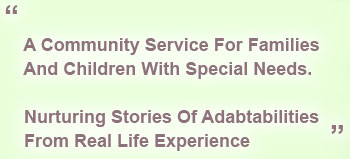Consulting and Conferencing:
Multiple Systems of Care
Progress from the Child and Family, to School and or Community. A Conference can bring all of these components together in a single setting, if needed.
- Partnerships are Strengthened through consultation. See Understanding Shared Conversations.
- A Child’s Four Worlds are Brought Forth.
- Conference Helpers Share purposes, date, time of meeting and gathering the members together. Refer to the School and Community Conference Arrangements.
- The members begin to talk to each other, dialogue the problems among each other, and witness the stories of strengths, needs and solutions.
- Remember, Fighting For Your Child is what it’s all about—and the stakes are high.
- A Photograph of the Child could be passed around at the meeting if he’s not present, even with a possible audio-tape by the child, introducing himself with statements of his own likes and dislikes.
- The Conference is Designed To Promote Respect, positive regard, and the best interest of the child while “rolling with” resistance. See Part I Section G – Motivation Building and the full text of Part I, which includes the case study and also, see the Solution Focus Handout.
- Be Aware of Resistance , which is felt by defensiveness, fear, hopelessness, reluctance, angry disputing, mismatch between client needs and wants and what’s offered, as well as differences in personality and information processing.
- Respond to Resistance by Reflecting Feelings and messages back and acknowledging the view. Then shift focus away from stumbling blocks. Use reframing, or offer another interpretation. Reassess what’s offered by the person with what’s requested. Describe both sides of the dilemma.
- Offer an opportunity to Expand the View of the Child being worked with, at the same time staying action and outcome-focused.
- Stay More Conflict-Free through respectful efforts within the group.
- Some Challenging Behaviors or Bad News is Inevitable , though a conference approach focuses on best outcomes, but is hopefully dealt with in a non-blaming and non-confrontational way. Visit the website motivationalinterview.org for pros and cons in dealing with both sides of an argument.
- Agreeable Conversation are Fostered through conferencing ideas, so maintain non-judgmental acceptance, determine the degree of discrepancy between where the client-family is, what they are doing, where they want to be, or if they prefer something else. Establish open-ended questions around the family’s own wishes, goals, hopes and dreams.
- Be Aware of and Reflect on Inconsistencies or Contradictions. Avoid arguing or debating, and use empathic summaries in concluding an issue. Ask, “How have you managed to cope against the odds?” or other questions about survival.
- This may be a time to Help an Individual Become Aware of Struggles in his or her ownlife that may be interfering with progress in the dialogue. “Ghosts” of past negative personal experiences may have been getting in the way.
- Reduce Power Struggles by perhaps expanding conference composition; after all, strong alliances often develop as well.
Transition Statement to Next Topic
_______________________________________________________
Finally, this model calls forth participating caregivers who join the family as a part of their social network for only a prescribed period of time. When the client- family is feeling greater strength of purpose and is more connected to ongoing natural supports, the team members might further remove themselves enabling future meetings and dialogues to occur naturally-speaking among personal networks.
_______________________________________________________








Social Networks
Follow Us